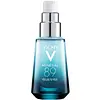What's inside
What's inside
 Key Ingredients
Key Ingredients

 Benefits
Benefits

 Concerns
Concerns

 Ingredients Side-by-side
Ingredients Side-by-side

Water
Skin ConditioningGlycerin
HumectantPropanediol
SolventCaprylic/Capric/Succinic Triglyceride
EmollientAlcohol
AntimicrobialLauroyl Lysine
Skin ConditioningMaltitol
HumectantPEG-60 Hydrogenated Castor Oil
EmulsifyingSqualane
EmollientPEG-32
HumectantPEG-8
HumectantPentylene Glycol
Skin ConditioningAcrylates/C10-30 Alkyl Acrylate Crosspolymer
Emulsion StabilisingAvena Sativa Kernel Extract
AbrasiveChlorphenesin
AntimicrobialMaltodextrin
AbsorbentParfum
MaskingPEG-7 Glyceryl Cocoate
EmulsifyingSynthetic Fluorphlogopite
CI 77891
Cosmetic ColorantAscorbyl Glucoside
AntioxidantHydroxyacetophenone
AntioxidantLecithin
EmollientSodium Hydroxide
BufferingPyrus Cydonia Seed Extract
MaskingHydrolyzed Soy Flour
Skin ConditioningAlcaligenes Polysaccharides
EmollientBiosaccharide Gum-2
Skin ConditioningAdenosine
Skin ConditioningSodium Benzoate
MaskingSorbitol
HumectantXanthan Gum
EmulsifyingBiosaccharide Gum-1
HumectantAlgin
MaskingBacillus Ferment
Skin ConditioningPolyvinyl Alcohol
Potassium Sorbate
PreservativeCellulose Gum
Emulsion StabilisingTin Oxide
AbrasiveSkeletonema Costatum Extract
Skin ConditioningCitric Acid
BufferingAscorbyl Palmitate
AntioxidantTocopherol
AntioxidantWater, Glycerin, Propanediol, Caprylic/Capric/Succinic Triglyceride, Alcohol, Lauroyl Lysine, Maltitol, PEG-60 Hydrogenated Castor Oil, Squalane, PEG-32, PEG-8, Pentylene Glycol, Acrylates/C10-30 Alkyl Acrylate Crosspolymer, Avena Sativa Kernel Extract, Chlorphenesin, Maltodextrin, Parfum, PEG-7 Glyceryl Cocoate, Synthetic Fluorphlogopite, CI 77891, Ascorbyl Glucoside, Hydroxyacetophenone, Lecithin, Sodium Hydroxide, Pyrus Cydonia Seed Extract, Hydrolyzed Soy Flour, Alcaligenes Polysaccharides, Biosaccharide Gum-2, Adenosine, Sodium Benzoate, Sorbitol, Xanthan Gum, Biosaccharide Gum-1, Algin, Bacillus Ferment, Polyvinyl Alcohol, Potassium Sorbate, Cellulose Gum, Tin Oxide, Skeletonema Costatum Extract, Citric Acid, Ascorbyl Palmitate, Tocopherol
 Reviews
Reviews

Ingredients Explained
These ingredients are found in both products.
Ingredients higher up in an ingredient list are typically present in a larger amount.
Adenosine is in every living organism. It is one of four components in nucleic acids that helps store our DNA.
Adenosine has many benefits when used. These benefits include hydrating the skin, smoothing skin, and reducing wrinkles. Once applied, adenosine increases collagen production. It also helps with improving firmness and tissue repair.
Studies have found adenosine may also help with wound healing.
In skincare products, Adenosine is usually derived from yeast.
Learn more about AdenosineBiosaccharide Gum-1 is a sugar created by fermenting sorbitol (which usually comes from potato starch!). It is known for its soothing and moisturizing properties.
Manufacturer tests show this ingredient helped reduce irritation from lactic acid by almost half and kept skin hydrated long-term as a humectant
Beyond hydration, Biosaccharide Gum-1 gives formulas a silky, non-sticky feel.
This ingredient is gentle, versatile, and suitable for all skin types.
Fun fact: Similar sugars can be found naturally in fruits like apples and pears.
Learn more about Biosaccharide Gum-1Citric Acid is an alpha hydroxy acid (AHA) naturally found in citrus fruits like oranges, lemons, and limes.
Like other AHAs, citric acid can exfoliate skin by breaking down the bonds that hold dead skin cells together. This helps reveal smoother and brighter skin underneath.
However, this exfoliating effect only happens at high concentrations (20%) which can be hard to find in cosmetic products.
Due to this, citric acid is usually included in small amounts as a pH adjuster. This helps keep products slightly more acidic and compatible with skin's natural pH.
In skincare formulas, citric acid can:
While it can provide some skin benefits, research shows lactic acid and glycolic acid are generally more effective and less irritating exfoliants.
Most citric acid used in skincare today is made by fermenting sugars (usually from molasses). This synthetic version is identical to the natural citrus form but easier to stabilize and use in formulations.
Read more about some other popular AHA's here:
Learn more about Citric AcidGlycerin is already naturally found in your skin. It helps moisturize and protect your skin.
A study from 2016 found glycerin to be more effective as a humectant than AHAs and hyaluronic acid.
As a humectant, it helps the skin stay hydrated by pulling moisture to your skin. The low molecular weight of glycerin allows it to pull moisture into the deeper layers of your skin.
Hydrated skin improves your skin barrier; Your skin barrier helps protect against irritants and bacteria.
Glycerin has also been found to have antimicrobial and antiviral properties. Due to these properties, glycerin is often used in wound and burn treatments.
In cosmetics, glycerin is usually derived from plants such as soybean or palm. However, it can also be sourced from animals, such as tallow or animal fat.
This ingredient is organic, colorless, odorless, and non-toxic.
Glycerin is the name for this ingredient in American English. British English uses Glycerol/Glycerine.
Learn more about GlycerinPropanediol is an all-star ingredient. It softens, hydrates, and smooths the skin.
It’s often used to:
Propanediol is not likely to cause sensitivity and considered safe to use. It is derived from corn or petroleum with a clear color and no scent.
Learn more about PropanediolWater. It's the most common cosmetic ingredient of all. You'll usually see it at the top of ingredient lists, meaning that it makes up the largest part of the product.
So why is it so popular? Water most often acts as a solvent - this means that it helps dissolve other ingredients into the formulation.
You'll also recognize water as that liquid we all need to stay alive. If you see this, drink a glass of water. Stay hydrated!
Learn more about Water